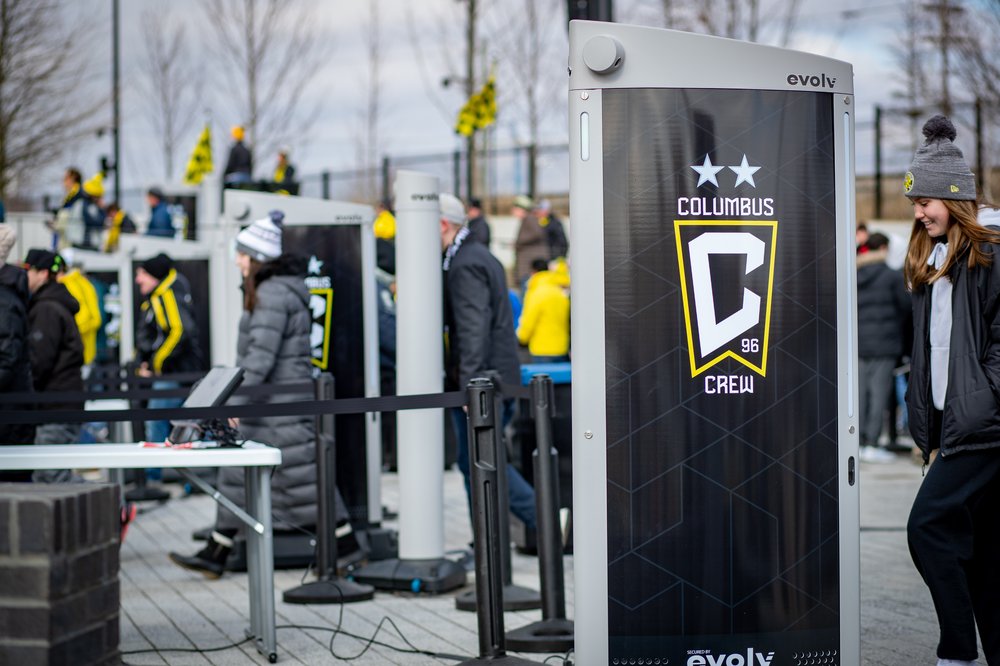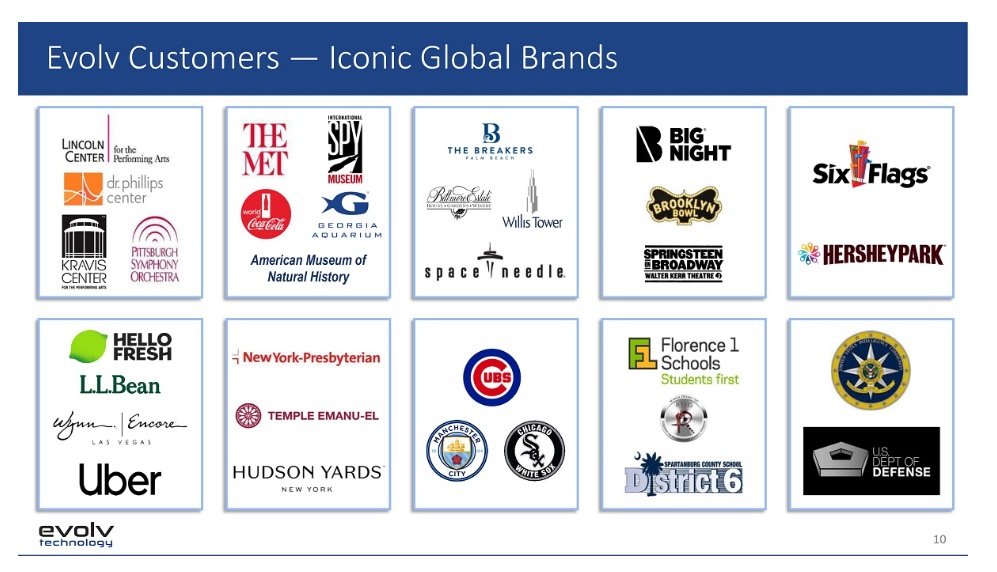This ‘weapon detector’ is under consideration for NYC subways after Sunset Park shooting
April 15, 2022, 10:48 a.m.
Evolv uses an array of magnetic sensors to spot when a person is carrying metal, but critics worry about the potential for false positives.

In the wake of the Sunset Park subway shooting, Mayor Eric Adams floated the idea of adding “something like metal detectors” to the entrances of stations to prevent weapons from getting onto trains. The comment created immediate pushback, as some questioned the feasibility of installing metal detectors at every turnstile across the city’s 472 stations.
Any New Yorker who has traveled by airplane knows that standard metal detectors are slow. No one wants to put their phone in a little bin while they’re rushing to their workplace. A spokesperson for the mayor later clarified that Adams wasn’t referring to airport-style detectors because “he knows that’s not practical.”
Adams, instead, was hinting at a new-age scanner that millions of New Yorkers are already walking through every year. City Hall has confirmed to Gothamist that one of the detectors under consideration is made by Evolv Technology, a security company based in Waltham, Massachusetts.
Like other metal detectors, Evolv uses an array of magnetic sensors — 50 in total — to spot when a person is carrying metal. But these sensors are linked to machine-learning algorithms, a type of artificial intelligence, so that the company can not only spot a metallic object, but figure out its density or shape — such as the barrel of a gun.
Evolv officials say their main goal is to prevent mass casualty threats to a crowd by detecting weapons such as guns, large knives and bombs.
“We've written all the signatures for all the weapons out there,” Evolv CEO Peter George told Gothamist. “The magic is in the ability to discriminate between a phone and a firearm.”
When the scanner gets a hit, the system snaps a photo of the person and a red 3-D box hovers over where the suspicious object might be. The image also allows a nearby security guard to pull the person out of a crowd. This automated setup allows for a higher volume of foot traffic. The company says that its base model — the Evolv Express — can screen about 3,600 people per hour, which it says is 10 times faster than traditional metal detectors.
No stopping. No emptying your pockets. Screening up to 3600 people an hour. Watch our systems work in this video.#SecurityScreening #TouchlessSecurity #DemandEvolv pic.twitter.com/B9UmpjwKEz
— Evolv Technology (@EvolvTechnology) April 14, 2022
George told Gothamist that the company’s devices have screened 11 million New Yorkers since rolling out in the city three years ago, a hefty tally given that the pandemic stymied public gatherings. Their rollout includes houses of worship, museums, performing arts sites and popular tourist sites in New York, he said.
Company documents state that Evolv scanners are already used by Lincoln Center, New York-Presbyterian Hospital, the Metropolitan Museum of Art, the American Museum of Natural History and MoMA. City Hall said Citi Field is also relying on the technology, though a spokesperson for The New York Mets referred all questions on the matter back to the Mayor’s Office.
“Of course, any technology that could possibly be utilized in the subways would be coordinated with the governor’s office and the MTA before ever being used and would need to complement existing technology already present in our subways,” Fabien Levy, the mayor’s press secretary, said in an email to Gothamist

But the New York City transit system is no museum when it comes to the number of people passing through it. On Tuesday, when the 36th Street Station shooting occurred, the subway carried 3 million riders, and that large volume is half of what used to occur before the pandemic.
Privacy advocates and security watchdogs are worried that putting this type of mass surveillance technology on the subway could inadvertently sweep up people without weapons.
“It also touts combining this object technology with video surveillance and video analytics, including the face recognition,” said Donna Lieberman, executive director of the New York Civil Liberties Union, “which is also notoriously error-ridden, particularly when it comes to Black and brown people.”
Would these weapons detectors work for the NYC subway?
That’s the question the Mayor’s Office wants to answer before pushing the MTA to pursue the technology.
As Gotham Gazette reported last month, New York City Health + Hospitals is piloting Evolv scanners at Jacobi Medical Center in the Bronx after a shooting occurred there in January. City Hall said it wants to analyze how the pilot program worked before determining whether or not to move forward with it.
“Mayor Adams has made clear that public safety is his top priority, and he is willing to test and analyze numerous forms of technology in a legal, responsible way to protect New Yorkers,” Levy said.
Evolv detectors operate on different sensitivity settings, and this tuning enables whether metal objects are spotted at higher and lower rates. But the barrels of guns resemble other tubular items that New Yorkers might carry into museums or schools, such as umbrellas.
“What Evolv is able to do is they have the ability to differentiate some objects from being benign or being an actual object of concern,” said Donald Maye, a former Army officer who is head of operations at IPVM, a research firm that specializes in video surveillance and security industry.
The public, who is oftentimes the subject of this technology, should know what its true capabilities are.
Donald Maye, head of operations at IPVM
But Maye wants the company to be more transparent about its weaknesses, namely the potential for false positives. Evolv detectors were recently reviewed by independent investigators at The University of Southern Mississippi, which runs the National Center for Spectator Sports Safety and Security (NCS4). This center conducts field exercises to see if emerging security technologies meet federal standards.
The center gave Evolv a high overall score with regard to detecting weapons and avoiding false alerts, beating out a competitor Patriot One Technologies. (Patriot One’s scanners reportedly had an issue with creating false alerts with Apple Watches and AirPods). But the NCS4 evaluators only released a partial 25-page report for Evolv, whereas the assessment for Patriot One is more detailed and runs 61 pages. Evolv’s full report is only available upon request with the company “under non-disclosure to qualified security professionals with direct responsibility for deployment of Evolv Express.”
“Our contention, as an organization that reports on this, is that transparency is what's important, and this information should be made public,” Maye said. “The public, who is oftentimes the subject of this technology, should know what its true capabilities are.”
Even though Evolv detectors can distinguish some benign objects — umbrellas, strollers, eyeglass cases — from weapons, an Eastern Illinois school district reported last autumn that the system struggles with Google Chromebook.
“Chromebooks have metallic hinges that are tubular in shape,” Maye said. “So at certain sensitivity settings, we know that Chromebooks will alert as a gun.”
Maye added that the school district used a workaround where students hold the Chromebooks above their heads or out in front when passing through the scanner. IPVM has written a number of critical analyses of the Evolv detectors — to the point that the two groups are no longer communicating with each other, Maye said.
Read More: Many cities have more robust subway camera systems than NY
No technology is foolproof, and given that Evolv uses machine-learning algorithms, the system is designed to become smarter over time to reduce false flags. George, the Evolv CEO, also said that the company recommends their systems be manned by security guards so that the true threats can be verified.
In the case of New York City’s subway system, that means police officers would need to be near every turnstile across the five boroughs. By screening 3,600 people per hour, single Evolv detectors could potentially handle the foot traffic going through the subway system. Times Square, the city’s busiest station, is currently fielding about 74,000 entries per day — or an average of 3,000 travelers every hour. (Some periods, such as rush hour, obviously see a lot more people.)
The placement of the detectors is another major consideration. Earlier this year, a person stabbed multiple staff members at MoMA’s welcome desk even though Evolv detectors were on hand. That’s because the scanners weren’t placed right behind the doorways — but rather a few yards back. George said the company is working on a version of the device that could be embedded in doorways and indoor jams.
Lieberman from NYCLU also wondered whether mass surveillance could truly address the roots of crime.
“The COVID pandemic has surfaced so many gaping holes in our social safety net,” she said. “The lack of affordable housing across the board, the lack of supportive housing for people in distress and suffering mental illness.”
Gothamist asked the MTA if it is considering Evolv Technology or similar weapons detectors, and a spokesperson pointed to comments made Thursday by Chair Janno Lieber.
“If there are technologies that can make everybody feel safe, make it even more desirable to share in what is our birthright as New Yorkers (the subway and mass transit), I'm all for it,” he said. “I just don't know enough about how they would work in the subway. All I've said so far is I'm for every idea being studied that could work.”